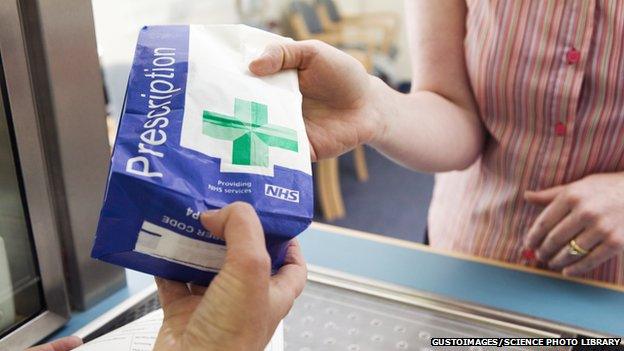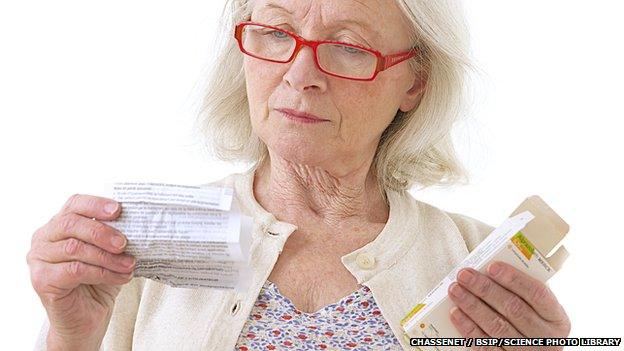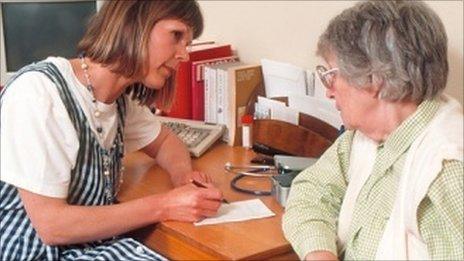Would pictures help patients understand prescriptions?
- Published
- comments

How easy is it to understand instructions on medicine labels and leaflets?
In a hospital in Lahore, Pakistan, patients use simple pictures of the sun rising over the mountains and the moon and stars at night to help them understand when to take their medication and how long to take it for.
With about half of patients at the hospital unable to read or write, written instructions on prescriptions and medicine labels are virtually useless.
In the UK, where about one in six people is thought to be "functionally illiterate" - defined as being unable to pass an English GCSE - could pictures and symbols improve patient understanding too?
Taking the wrong dose of medicine can be dangerous. It can put patients' lives at risk.
According to the Patients Association, their helpline receives many calls from patients concerned about whether they have taken the right quantity of medicine at the right time.
Dr Mike Smith, chairman of the association, says labelling is a patient safety issue.
"There are many elderly patients who may find the writing in small font on the coloured labels on bottles and packets of medicines difficult to read."
The instructions are usually typed, first by the GP on the prescription form, then re-typed and added to by a pharmacist who attaches them to the medicine bottle and box itself.
So could using pictures make things easier?

The redesigned picture-based prescription improved the understanding of patients in Lahore
"Using pictures and clarity of labels will certainly help the adherence to medications, which in turn will reduce the need to seek help from emergency services due to medication errors," Dr Smith says.
He adds that the use of pictures on labels could also help patients with mild learning difficulties or dementia.
Target groups
At Services Hospital in Lahore, Dr Matthew Clayton and colleagues designed the new prescription form for patients, based on pictures rather than words (see image above). It also requires the pharmacists to write the number for each medication, as it appears on the form, on to the corresponding box of tablets.
His report, external on the experiment, published by the BMJ this week, describes an approximate 20% increase in illiterate patients' understanding when using the new form.
Literacy levels are much higher in the UK, but there are still many groups who could potentially benefit.
Dr Mobasher Butt, clinical lead at BMJ Learning and Quality Improvement, and a GP in London, says patients with visual impairments, learning disabilities, mental health problems and those taking lots of different medications could all be helped by a picture-based approach.
He said: "Given the diversity of population we look after, symbols could certainly help reinforce verbal messages.
"When we give patients a prescription we normally explain when to take the medicine and how often, then that message is reiterated by the pharmacist.
"But if the patient has the added advantage of picture and symbols to go on, that would really help."
However, not everyone agrees.

The patient information leaflet (PIL) tends to focus on the harms and side-effects of drugs
'Not simple'
Theo Raynor, professor of pharmacy practice at the University of Leeds, and an expert on the information provided with medicines in primary care, says pictures can be confusing and give patients completely the wrong idea.
Because most people in the UK can read and write to some degree, the priority should be to make information on prescriptions and labels "as clear and simple as possible".
He cites the example of a symbol featuring a baby with a cross through it, meaning "keep out of the reach of children".
"Some people thought it meant 'don't take if pregnant', others thought it meant 'this medicine is a contraceptive' and others 'don't give to children'.
"Pictures sound like a really easy answer - but they can cause more problems than they solve."
Prof Raynor says pictures have to be tested on patients and then patients should be taught how to interpret them, otherwise they are anything but simple.
Where he thinks attention should really be focused is on the patient information leaflets (PILs) that come inside the medicine box.
At present, they are text-heavy and complicated.
Better balance
"There's too much about the harms and side-effects of medicines. The information needs to be more balanced," Prof Raynor says.
"People like to have that leaflet, so there should be more about how they can benefit from the medication."
Dr Butt agrees that the information in the PIL can be "overwhelming" for patients and sometimes it contradicts what the GP has recommended.
Between the patient's name, date of birth and details of the medication, there is evidently little room for instructions on a label, which is why the Medicines and Healthcare Products Regulatory Agency guidelines stress the need for healthcare professionals and pharmaceutical companies to "use simple words of few syllables".
The use of pictures on prescriptions in Lahore did not completely solve the problem for illiterate patients, so there is obviously still work to do on a perfect solution.
- Published1 July 2011

- Published4 March 2011